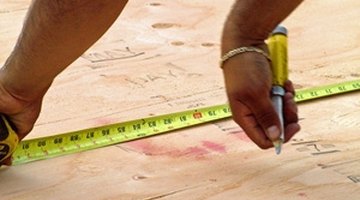How to Prepare a Floor Surface With Luan for Vinyl Floor Covering
Luan, also known as Philippine mahogany, is a soft wood usually found in 1/4-inch thick sheets. Used as an underlayment for vinyl atop hardwood or tiled floors, luan provides a smooth, level surface that prevents imperfections in the subfloor from telegraphing through thin vinyl, marring the look of the vinyl after installation. There are better substances for use as an underlayment for your vinyl floor covering, but luan is inexpensive and quick to install.

-
Sweep the floor to remove any dirt or debris. Check that the floor is level using a leveling bar. Drag the flat edge of the bar over the floor, noting any high or low areas. Mark the rises and dips with a marker for later leveling. Remove any trim or baseboard surrounding the floor to gain complete access to the entire floor’s surface.
-
Sand down high levels to the point of the surrounding subfloor using a floor sander. Sweep the sanding residue from the area. Fill in any depressions in the floor using self-leveling compound. Spread the compound through the depression with a trowel, until the low area is level with the surrounding surface. Allow the compound to dry overnight.
-
Lay down a layer of luan boards over the surface of the floor. Begin by placing full-sized boards across the surface of the floor along one line. Measure the space left over at the end of the row, and cut a partial board to fit the measurement. Place the partial board so that the factory edge butts against the full-sized board. Start the next row with the remaining piece of that partial board so that adjacent rows of boards have staggered joints. Continue in this manner until the entire floor is covered.
-
Staple the boards in place using 7/16 crown staples. Place a staple around the edges of the luan every 6 inches, and across the center of the boards every 8 inches.
-
Check each staple and make sure it’s fully embedded into the luan. Hammer down partially placed staples to keep them from deforming the vinyl. Examine the seams between boards for smoothness. If any rough areas are present, sand them smooth with medium-grit sandpaper. After smoothing, the luan boards are ready for the vinyl.
References
Resources
Tips
- Use the highest quality luan boards you can find as underlayment to avoid bad places in the wood or thickness variances.
Warnings
- As a softer wood, luan may not stand up well under heavy loads such as furniture.
Writer Bio
Larry Simmons is a freelance writer and expert in the fusion of computer technology and business. He has a B.S. in economics, an M.S. in information systems, an M.S. in communications technology, as well as significant work towards an M.B.A. in finance. He's published several hundred articles with Demand Studios.
Photo Credits
- construction ,measuring image by Greg Pickens from Fotolia.com
More Articles



